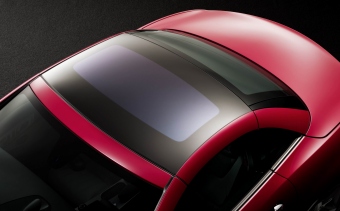
Automotive Intelligence - the web for automotive professionals and car enthusiasts
November 03, 2010
This Week:
-
The new BMW X3 - A new dimension to the pleasure of driving a Sports Activity Vehicle
-
The sound of silence: How Audi is working on the acoustics of future electric cars
-
BMW Concept C. - The scooter of the future made by BMW Motorrad
-
Audi Group Reports Record Operating Profit of € 940 Million in Third Quarter
-
New Volunteer VTX Cross-Over Concept Stakes Claim in New UTV Class at SEMA
© 1998 - 2010
Copyright &
Disclaimer
Automotive Intelligence,
www.autointell.com
All Rights Reserved .
For questions please contact
editor@autointell.net
|
The new Mercedes-Benz SLK with MAGIC SKY CONTROL
Stuttgart – Mercedes-Benz is enhancing the vario-roof of the SLK with innovative technology boasting entirely new features. As a result, a totally unique glass roof will be celebrating its world premiere in the new SLK next year: at the touch of a button it can be made either transparent or darkened. In transparent mode it will offer an open-air experience during cold weather, while in darkened mode it will afford a haven of shade and prevent the interior from heating up in direct sunlight. Mercedes-Benz will be the first automotive manufacturer to offer the new glass roof – called the panoramic vario-roof with MAGIC SKY CONTROL – as an optional extra in the new SLK next year. Thanks to this new development, the transparent glass roof can be darkened on demand in a matter of seconds. By affording shade and a unique ambience, it helps to ensure a pleasant wellness atmosphere in the vehicle interior. |
|
|
|
Since the innovative glass also shields against the sun's rays far more effectively than conventional thermal insulation glass or sunblinds, the occupants of the new SLK will also enjoy the highest level of climatic comfort at the same time. When driving with the roof open would be unpleasant due to intense heat, the driver and front passenger are able to remain composed under the MAGIC SKY CONTROL roof – an important contribution towards feeling comfortable and driver-fitness safety, a concept typically promoted by Mercedes. |
|
Even when the vehicle is at a standstill the interior does not overheat, since the roof is switched to darkened mode when powered off. The operating principle is based on the physics of a plate condenser: if the glass structure is subjected to an electrical voltage, particles in the structure position themselves so that light is able to pass through the glass. If the voltage remains switched off, however, the particles position themselves randomly. This partially blocks the light, and the glass remains dark. The control unit and converter are integrated into the front section of the roof, and the switch is in the overhead control console. In addition to the unique panoramic effect and transparency at the touch of a button, MAGIC SKY CONTROL also provides a top-class wellness atmosphere. UV and infrared light are also effectively blocked in transparent mode, while insulation increases even more significantly and noticeably in darkened mode, thereby helping to keep the temperature on interior parts such as armrests cooler by up to 10 degrees Celsius compared with conventional green glass. The demanding Mercedes-Benz endurance test programme which prototypes fitted with the switchable glass roof had to pass around the globe included harsh practical tests conducted in Death Valley in the USA – one of the hottest places on earth. Under the heat of the baking sun, summer temperatures there regularly hit over 50 degrees Celsius in the shade. The test engineers made the most of these conditions to heat up the SLK prototypes with transparent roofs for four hours around midday, for example. They then switched the roofs to non-transparent mode and immediately noticed significant relief from the torturing heat. Thermal images showed that temperatures in the region of the head were reduced. Measurements using a device called a star pyranometer revealed why this was the case. This device measures the intensity of exposure to sunlight. With an open roof, the load from the sun in the heat of Death Valley reached 1000 to 1100 W per square metre. With the transparent glass roof it dropped to 200 W, and when the roof was switched to darkened mode with MAGIC SKY CONTROL, it dropped to 40 to 50 W – one 20th of the original value. But MAGIC SKY CONTROL not only benefits passengers. Some of the strain is also taken off the air-conditioning system, thereby in turn saving on CO2 emissions. The panoramic vario-roof with MAGIC SKY CONTROL will be available to order as an optional extra for less than 2000 euros. Photo: MB (Oct 29, 2010) |
|
